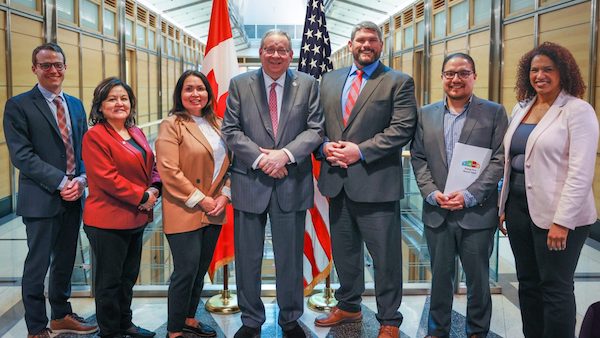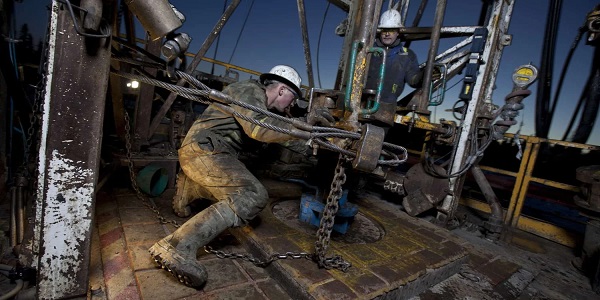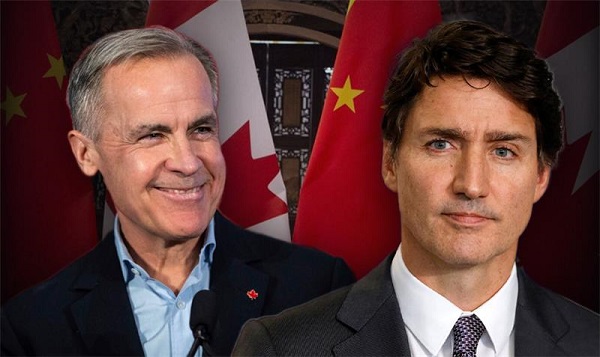Canadian Energy Centre
Indigenous leaders meet G7 diplomats to make case for Canadian LNG

Indigenous leaders meet with U.S. ambassador to Canada David Cohen. Photo courtesy Energy for a Secure Future
From Shawn Logan of the Canadian Energy Centre Ltd.
‘Every official had a real desire to really understand Indigenous sentiment around resource development’
As G7 leaders left Hiroshima, Japan last month, they made a significant admission that liquefied natural gas (LNG) is a critical fuel to help reduce dependence on Russian energy, and that increased natural gas investment is important.
“In this context, we stress the important role that increased deliveries of LNG can play and acknowledge that investment in the sector can be appropriate in response to the current crisis and to address potential gas market shortfalls provoked by the crisis,” wrote the G7 in their final communique last week.
The decision comes just weeks after a small group of Indigenous leaders went to Ottawa to meet face-to-face with diplomats from some of the world’s top economies, convened by Energy for a Secure Future.
Their message to the world was simple: Indigenous communities in Canada can and should be partners at the table when it comes to developing and sharing our country’s vast natural resources. And it may have resonated.
For John Desjarlais, executive director of the Indigenous Resource Network, the vote of confidence for LNG is music to his ears.
“I’d like to think that we were heard – we met with some pretty influential people and heard some of the right things,” he said.
“For them to make that commitment is a big deal, and certainly a difference from some of the early indicators before the G7.”

Tapped earlier this year as the new executive director of the Indigenous Resource Network, Desjarlais found himself in Ottawa with other Indigenous leaders in April, meeting with diplomatic representatives from Canada’s G7 partners – Germany, France, Japan and the United States – as well as delegations from Poland and India.
Desjarlais said he was surprised just how open diplomats were to the notion that Indigenous communities in Canada can be key players in the global energy marketplace.
“What a whirlwind. It was inspiring, especially speaking with the ambassadors,” Desjarlais said of the two-day diplomatic blitz that both challenged perceptions and paved a path for Indigenous voices to play a greater role on the international stage.
“Every official had a real desire to really understand Indigenous sentiment around resource development. There was a sincere desire to learn from our perspective.”
First Nations and Metis have emerged as key partners in Canadian resource projects, particularly the country’s nascent LNG industry.
Global demand for reliable and responsibly produced LNG has continued to grow, with Russia’s invasion of Ukraine last year thrusting it into even greater prominence. The leaders of Canada’s G7 partners Germany and Japan both came to Canada last year to make direct appeals for more Canadian LNG – they left with no firm commitments.

Desjarlais and a group of fellow Indigenous leaders who are on the advisory council for Energy for a Secure Future – a non-partisan coalition of business, labour and Indigenous representatives – outlined their vision for how Canada and First Nations can help be a solution in the drive for increased global energy security, while also helping lower emissions by providing a cleaner alternative to coal.
Crystal Smith, chief councillor of the Haisla Nation on B.C.’s coast, said the first step is dispelling the notion that Indigenous people oppose resource development in Canada.
“When Europeans, Asians and Americans think of Canada’s Indigenous peoples, they often think we oppose all energy development,” she said during a press conference to mark April’s diplomatic meetings.
“We aren’t victims of development. Increasingly we are partners and even owners in major projects.”
The Haisla Nation has a 50 per cent ownership stake in the proposed $3-billion Cedar LNG project, which was granted regulatory approval earlier this year, and is expected to begin operations in 2027.
It marks the largest Indigenous-owned infrastructure project in Canadian history, as well as the first Indigenous-owned LNG terminal in the world.

Karen Ogen, CEO of the First Nations LNG Alliance, said it’s projects like Cedar LNG and others currently under development that will not only help Indigenous communities achieve prosperity, but help the global community in the quest for vital energy security.
“LNG development has provided immediate- and medium-termed opportunities to lift thousands of Indigenous people and our communities out of inter-generational poverty,” she said.
“We are determined to develop our resources in a socially and environmentally responsible way. We want to work with Canada and our allies in the G7 to bring urgency to the development and export of Canadian LNG.”
Beyond Cedar LNG, dozens of First Nations and Métis communities have entered into equity ownership agreements in pipelines, LNG facilities and carbon capture and storage projects, among others.
The Ksi Lisims LNG project, a joint venture with the Nisga’a Nation in northern B.C., has been granted a 40-year export licence from the Canada Energy Regulator, while in Atlantic Canada the Miawpukek First Nation is a part-owner of the proposed export project LNG Newfoundland and Labrador.
Large consortiums representing Indigenous communities have also acquired or are looking to acquire stakes in major pipeline projects including Coastal GasLink, Trans Mountain, and several oil sands pipelines.
According to Desjarlais, the Ottawa summit proved to be a fruitful meeting of the minds. He said it could signal a more important role for Indigenous communities both as more equal resource partners in Canada, but on the world stage as well. The group has been asked to meet again in June with U.S. ambassador David Cohen.
“I never thought it would accelerate to this point – it’s accelerating so fast,” he said.
“Ownership is reconciliation. There’s a whole cascade of benefits that come from these projects everywhere.”
Alberta
‘Weird and wonderful’ wells are boosting oil production in Alberta and Saskatchewan

From the Canadian Energy Centre
Multilateral designs lift more energy with a smaller environmental footprint
A “weird and wonderful” drilling innovation in Alberta is helping producers tap more oil and gas at lower cost and with less environmental impact.
With names like fishbone, fan, comb-over and stingray, “multilateral” wells turn a single wellbore from the surface into multiple horizontal legs underground.
“They do look spectacular, and they are making quite a bit of money for small companies, so there’s a lot of interest from investors,” said Calin Dragoie, vice-president of geoscience with Calgary-based Chinook Consulting Services.
Dragoie, who has extensively studied the use of multilateral wells, said the technology takes horizontal drilling — which itself revolutionized oil and gas production — to the next level.
“It’s something that was not invented in Canada, but was perfected here. And it’s something that I think in the next few years will be exported as a technology to other parts of the world,” he said.
Dragoie’s research found that in 2015 less than 10 per cent of metres drilled in Western Canada came from multilateral wells. By last year, that share had climbed to nearly 60 per cent.
Royalty incentives in Alberta have accelerated the trend, and Saskatchewan has introduced similar policy.
Multilaterals first emerged alongside horizontal drilling in the late 1990s and early 2000s, Dragoie said. But today’s multilaterals are longer, more complex and more productive.
The main play is in Alberta’s Marten Hills region, where producers are using multilaterals to produce shallow heavy oil.
Today’s average multilateral has about 7.5 horizontal legs from a single surface location, up from four or six just a few years ago, Dragoie said.
One record-setting well in Alberta drilled by Tamarack Valley Energy in 2023 features 11 legs stretching two miles each, for a total subsurface reach of 33 kilometres — the longest well in Canada.
By accessing large volumes of oil and gas from a single surface pad, multilaterals reduce land impact by a factor of five to ten compared to conventional wells, he said.
The designs save money by skipping casing strings and cement in each leg, and production is amplified as a result of increased reservoir contact.
Here are examples of multilateral well design. Images courtesy Chinook Consulting Services.
Parallel
Fishbone
Fan
Waffle
Stingray
Frankenwells
Alberta
How economic corridors could shape a stronger Canadian future

Ship containers are stacked at the Panama Canal Balboa port in Panama City, Saturday, Sept. 20, 2025. The Panama Canals is one of the most significant trade infrastructure projects ever built. CP Images photo
From the Canadian Energy Centre
Q&A with Gary Mar, CEO of the Canada West Foundation
Building a stronger Canadian economy depends as much on how we move goods as on what we produce.
Gary Mar, CEO of the Canada West Foundation, says economic corridors — the networks that connect producers, ports and markets — are central to the nation-building projects Canada hopes to realize.
He spoke with CEC about how these corridors work and what needs to change to make more of them a reality.
CEC: What is an economic corridor, and how does it function?
Gary Mar: An economic corridor is a major artery connecting economic actors within a larger system.
Consider the road, rail and pipeline infrastructure connecting B.C. to the rest of Western Canada. This infrastructure is an important economic corridor facilitating the movement of goods, services and people within the country, but it’s also part of the economic corridor connecting western producers and Asian markets.
Economic corridors primarily consist of physical infrastructure and often combine different modes of transportation and facilities to assist the movement of many kinds of goods.
They also include social infrastructure such as policies that facilitate the easy movement of goods like trade agreements and standardized truck weights.
The fundamental purpose of an economic corridor is to make it easier to transport goods. Ultimately, if you can’t move it, you can’t sell it. And if you can’t sell it, you can’t grow your economy.
CEC: Which resources make the strongest case for transport through economic corridors, and why?
Gary Mar: Economic corridors usually move many different types of goods.
Bulk commodities are particularly dependent on economic corridors because of the large volumes that need to be transported.
Some of Canada’s most valuable commodities include oil and gas, agricultural commodities such as wheat and canola, and minerals such as potash.
CEC: How are the benefits of an economic corridor measured?
Gary Mar: The benefits of economic corridors are often measured via trade flows.
For example, the upcoming Roberts Bank Terminal 2 in the Port of Vancouver will increase container trade capacity on Canada’s west coast by more than 30 per cent, enabling the trade of $100 billion in goods annually, primarily to Asian markets.
Corridors can also help make Canadian goods more competitive, increasing profits and market share across numerous industries. Corridors can also decrease the costs of imported goods for Canadian consumers.
For example, after the completion of the Trans Mountain Expansion in May 2024 the price differential between Western Canada Select and West Texas Intermediate narrowed by about US$8 per barrel in part due to increased competition for Canadian oil.
This boosted total industry profits by about 10 per cent, and increased corporate tax revenues to provincial and federal governments by about $3 billion in the pipeline’s first year of operation.
CEC: Where are the most successful examples of these around the world?
Gary Mar: That depends how you define success. The economic corridors transporting the highest value of goods are those used by global superpowers, such as the NAFTA highway that facilitates trade across Canada, the United States and Mexico.
The Suez and Panama canals are two of the most significant trade infrastructure projects ever built, facilitating 12 per cent and five per cent of global trade, respectively. Their success is based on their unique geography.
Canada’s Asia-Pacific Gateway, a coordinated system of ports, rail lines, roads, and border crossings, primarily in B.C., was a highly successful initiative that contributed to a 48 per cent increase in merchandise trade with Asia from $44 million in 2006 to $65 million in 2015.
China’s Belt and Road initiative to develop trade infrastructure in other countries is already transforming global trade. But the project is as much about extending Chinese influence as it is about delivering economic returns.

Piles of coal awaiting export and gantry cranes used to load and unload containers onto and from cargo ships are seen at Deltaport, in Tsawwassen, B.C., on Monday, September 9, 2024. CP Images photo
CEC: What would need to change in Canada in terms of legislation or regulation to make more economic corridors a reality?
Gary Mar: A major regulatory component of economic corridors is eliminating trade barriers.
The federal Free Trade and Labour Mobility in Canada Act is a good start, but more needs to be done at the provincial level to facilitate more internal trade.
Other barriers require coordinated regulatory action, such as harmonizing weight restrictions and road bans to streamline trucking.
By taking a systems-level perspective – convening a national forum where Canadian governments consistently engage on supply chains and trade corridors – we can identify bottlenecks and friction points in our existing transportation networks, and which investments would deliver the greatest return on investment.
-

 Alberta2 days ago
Alberta2 days agoFrom Underdog to Top Broodmare
-

 Business2 days ago
Business2 days agoMan overboard as HMCS Carney lists to the right
-

 Business2 days ago
Business2 days agoHigher carbon taxes in pipeline MOU are a bad deal for taxpayers
-

 Alberta2 days ago
Alberta2 days agoREAD IT HERE – Canada-Alberta Memorandum of Understanding – From the Prime Minister’s Office
-

 Daily Caller2 days ago
Daily Caller2 days agoZelenskyy Under Siege As Top Aide Resigns After Home Raided In Major Corruption Scandal
-

 Alberta2 days ago
Alberta2 days agoIEA peak-oil reversal gives Alberta long-term leverage
-

 Bruce Dowbiggin2 days ago
Bruce Dowbiggin2 days agoHealthcare And Pipelines Are The Front Lines of Canada’s Struggle To Stay United
-

 Alberta1 day ago
Alberta1 day agoAlberta can’t fix its deficits with oil money: Lennie Kaplan

















